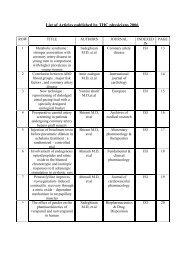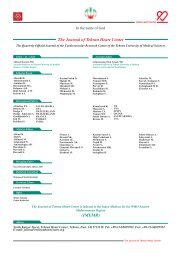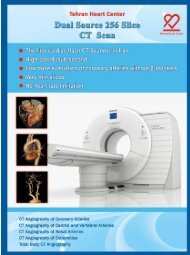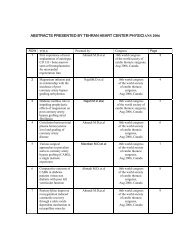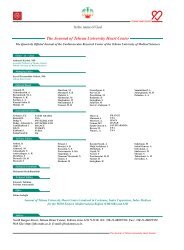Metabolic Syndrome: Stronger association With Coronary Artery
Metabolic Syndrome: Stronger association With Coronary Artery
Metabolic Syndrome: Stronger association With Coronary Artery
Create successful ePaper yourself
Turn your PDF publications into a flip-book with our unique Google optimized e-Paper software.
Clinical<br />
Investigation<br />
Mehrab Marzban, MD<br />
Reza Arya, MD<br />
Mohammad Hossein<br />
Mandegar, MD<br />
Abbas Ali Karimi, MD<br />
Kiomars Abbasi, MD<br />
Namvar Movahed, MD<br />
Seyed Hesameddin<br />
Abbasi, MD<br />
Key words: Comparative<br />
study; coronary artery<br />
bypass/methods; dissection/<br />
methods; papaverine; radial<br />
artery/transplantation;<br />
spasm/prevention &<br />
control; tissue and organ<br />
harvesting/methods;<br />
transplantation, autologous;<br />
vasoconstriction/prevention<br />
& control; vasodilator agents<br />
From: Department of<br />
Cardiothoracic Surgery<br />
(Drs. K. Abbasi, S.H. Abbasi,<br />
Arya, Karimi, Marzban, and<br />
Movahed), Tehran Heart<br />
Center, Tehran University<br />
of Medical Sciences;<br />
and Department of Cardiothoracic<br />
Surgery<br />
(Dr. Mandegar), Shariati<br />
Hospital; Tehran, Iran<br />
Address for reprints:<br />
Mehrab Marzban, MD,<br />
Department of<br />
Cardiothoracic Surgery,<br />
Tehran Heart Center, Jalal Al<br />
Ahmad & North Kargar Rd.<br />
Crossing, Tehran 14117, Iran<br />
E-mail: mehrabmarzban@<br />
yahoo.com<br />
© 2006 by the Texas Heart ®<br />
Institute, Houston<br />
Sharp Dissection versus<br />
Electrocautery for<br />
Radial <strong>Artery</strong> Harvesting<br />
Radial arteries have been increasingly used during the last decade as conduits for coronary<br />
artery revascularization. Although various harvesting techniques have been described,<br />
there has been little comparative study of arterial damage and patency.<br />
A radial artery graft was used in 44 consecutive patients, who were randomly divided<br />
into 2 groups. In the 1st group, the radial artery was harvested by sharp dissection<br />
and in the 2nd, by electrocautery. These groups were compared with regard to radial artery<br />
free flow, harvest time, number of clips used, complications, and endothelial damage.<br />
Radial artery free flow before and after intraluminal administration of papaverine was<br />
significantly greater in the electrocautery group (84.3 ± 50.7 mL/min and 109.7 ± 68.5<br />
mL/min) than in the sharp-dissection group (52.9 ± 18.3 mL/min and 69.6 ± 28.2 mL/<br />
min) (P=0.003). Harvesting time by electrocautery was significantly shorter (25.4 ± 4.3<br />
min vs 34.4 ± 5.9 min) (P=0.0001). Electrocautery consumed an average of 9.76 clips,<br />
versus 22.45 clips consumed by sharp dissection. The 2 groups were not different regarding<br />
postoperative complications, except for 3 cases of temporary paresthesia of<br />
the thumb in the electrocautery group; histopathologic examination found no endothelial<br />
damage.<br />
We conclude that radial artery harvesting by electrocautery is faster and more economical<br />
than harvesting by sharp dissection and is associated with better intraoperative<br />
flow and good preservation of endothelial integrity. (Tex Heart Inst J 2006;33:9-13)<br />
Using the radial artery (RA) as an arterial conduit was first proposed by<br />
Carpentier and colleagues in 1973; 1 but shortly thereafter, some surveys<br />
showed high occlusion rates, 2,3 which at last led to the abandonment of<br />
RA use. In the 1990s, studies showing long-term patency of RA grafts—of about a<br />
decade—revived the use of RA grafts, 4 so that nowadays the RA is increasingly<br />
used as the 2nd conduit of choice, after the internal mammary artery, 5 especially in<br />
cases of total arterial revascularization.<br />
The radial artery and other limb arteries are classified as type III, according to<br />
He’s functional classification system, 6 and are constructed predominantly of muscle<br />
cells (in the middle layer of their walls), which makes them vulnerable to vasospasm<br />
as a result of mechanical or thermal stimuli. 6,7 Furthermore, these arteries<br />
show a higher contractility in response to vasoconstrictors. 8 Early graft failures and<br />
occlusions were attributed to this vasospasm mechanism and to the endothelial<br />
damage caused by trauma during harvesting, which leads to a higher propensity<br />
for platelet aggregation and thrombosis. 9<br />
To prevent these events, the so-called minimally traumatic harvesting technique<br />
10,11 was developed to minimize touching and manipulating the vessel. In<br />
addition, various antispasmodic drug protocols were introduced to prevent vasospasm;<br />
these protocols included the use of vasodilator drugs such as verapamil,<br />
nitroglycerin, nitroprusside, milrinone, and papaverine, given singly or in combination.<br />
12-15 Acar and colleagues 14 suggested the systemic use of diltiazem and the<br />
topical or intraluminal use of papaverine; 4 furthermore, others 13 showed that 10<br />
minutes of exposure to intraluminal papaverine would result in near-maximal RA<br />
dilation.<br />
At our center, we started using RA for coronary artery bypass grafting (CABG)<br />
in 1999. Initially, we harvested the arteries by sharp dissection, which was very<br />
time-consuming and expensive, because it used too many hemostatic clips. Harvesting<br />
by electrocautery was thought to be free of these problems, but we were<br />
Texas Heart Institute Journal Sharp Dissection vs Electrocautery for Radial <strong>Artery</strong> 9



